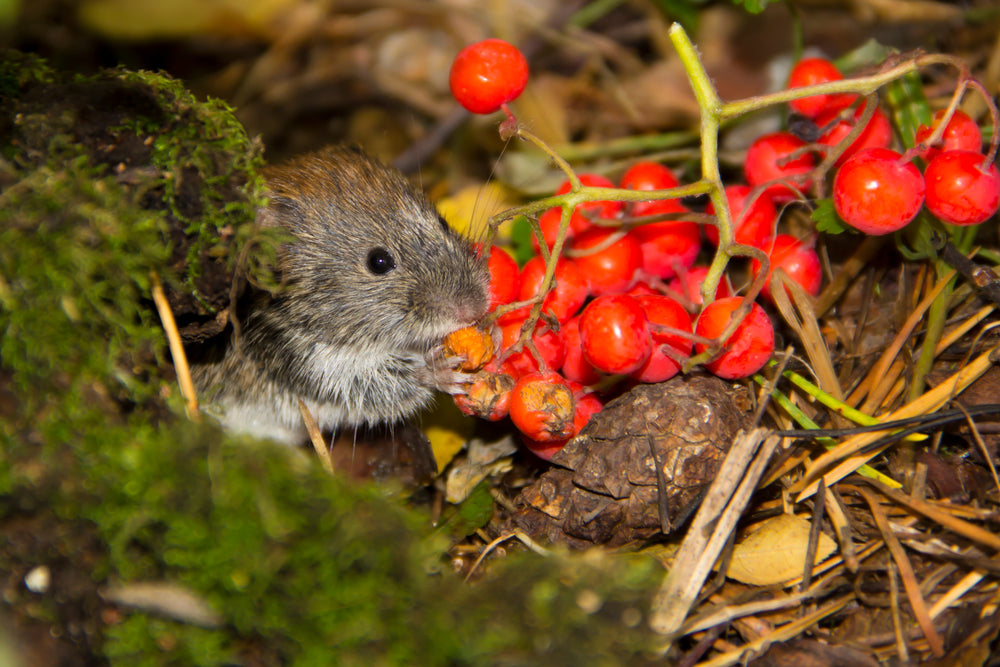When a deer or rabbit visits your garden, it's tough to miss the nibbled leaves, chewed shoots, and missing plants. Voles, on the other hand, can be harder to identify — but just as destructive. Small, shy, and somewhat pudgy, these rodents are frequently called meadow mice. They're about mouse-size (5-8 inches long at maturity), but have shorter tails and darker color (frequently brown-black, but can be red- or yellow-brown) than true mice. Voles also have small eyes and partially hidden ears. Before you begin laying plans for keeping voles out of the garden, you want be sure that voles are the culprits.
Signs of Vole Activity
Voles are a pest most often identified by the clues they leave behind. Here are some indicators that you may have a vole problem:
- Trails in the lawn. As voles travel the same paths, they create 1- to 2-inch-wide runways or ruts in the lawn. These runways are most apparent following a snowy winter. The snow provides cover for voles, which run through—and munch—grass all winter long.
- Cats. Watch for cats that sit in one spot and repeatedly catch something small. Voles are so numerous that cats don't have to wander to catch a meal's worth.
- Holes in the soil. Vole tunnels have openings 1.5 to 2 inches across and are typically hidden beneath mulch, shrubs, or spreading plants. Look for fresh grass clippings or seeds near tunnel entrances.
- Spongy soil. Some voles burrow and create many shallow tunnels, while other types dig down to a depth of 12 inches. The tunnels give soil a spongy feel when you walk on it. Voles also happily inhabit mole and chipmunk tunnels.
- Collapsed plants. Voles primarily eat plants. They like to feast on roots, tubers, or bulbs, which puts crops like onions, potatoes, sweet potatoes, turnips, and beets at risk. With the roots gone, plant tops collapse. Some voles also chew plants at the crown, causing the top to fall over.
- Damaged harvest. Voles also like to munch seeds and fruits, including beans, corn, and berries.
- Visual sighting. Voles scurry along soil, moving quickly from one shelter to another. In summer, if grass is long, you'll sometimes see what appears to be a ripple moving through grass. The cause of the ripple is often a vole (though it may be a snake)
Testing for Voles
If your garden borders a natural or wild area, both voles and moles are likely present. (Moles, with their preference for insects and grubs over plants, tend to do less damage to crops.) To determine which is romping through your garden, suspend a piece of apple on a stick just above the ground in a known run. Typically, animals will feed on the apple within 24 hours. Voles have classic rodent teeth, which leave distinct parallel marks on gnawed surfaces. Moles, on the other hand, have round teeth, which tend to shred.
Protecting your Garden Against Voles
Voles never hibernate, so protecting your garden is a year-round effort. Concentrate control efforts during the breeding season (spring to summer) to make a serious dent in the population. Try one of these techniques to keep voles in check.
Ground Clearing
Voles need cover to survive and avoid open ground. Cleared spaces as narrow as 10 inches inhibit their movements; wider areas are even better. Remove weeds, mulch, and any crop litter around the garden. In addition, either create a bare border space around your vegetable garden or dig a trench 12 inches deep and wide enough to step over easily (as shown in the illustration at the top of the page). When voles encounter the open trench, they'll retreat.



Repellents
Check with your local extension office or garden center to learn which repellents are labeled for use on voles. Some success has been reported with garlic tubes inserted into tunnels and hot sauce applied to the vegetation you wish to protect (avoid applying to portions you eat). Castor oil (granules or liquid) also has a repellent effect, as do sound-emitting spikes inserted into the soil. Note, though, that no repellent is 100 percent effective in all situations.
Mowing
Don't let grass grow too high. Longer grass provides easy cover for voles to escape predators.
Fencing
Protect plantings from voles with a fence that's buried 3 to 6 inches below the soil surface and bent outwards into an L-shape. Above ground, the fence should be from 4 to 12 inches tall. Use non-rusting, one-quarter-inch mesh. Hardware cloth works well.
Predators
One of the best defenses against voles is a cat. Other predators include owls, foxes, hawks, bobcats, some snakes, and coyotes.
Follow these steps and your tomatoes will stay strong and ready for a speedy return to growing and producing once the heat breaks.
Article by Julie Martens.Illustration by Steve Asbell of therainforestgarden.com.





 Herbs
Herbs
 Vegetables
Vegetables
 Fruit
Fruit
 Flowers
Flowers
 Succulents
Succulents


